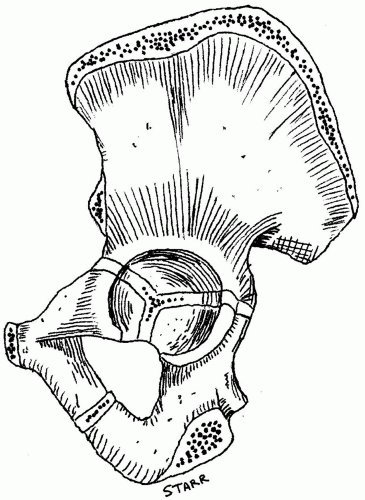Pelvic Fractures
Mark M. Pizzurro
Robert L. Kalb
Fractures of the pelvis encompass a wide spectrum of injuries ranging from the simple pubic ramus fracture to the life-threatening open pelvis. Low-energy trauma usually results in pubic ramus injuries, which are treated symptomatically. In contrast, high-energy injuries, which occur most commonly from motor vehicle accidents, can include open fractures of the pelvis, acetabulum fractures with hip dislocations, and unstable pelvic ring fractures.
The pelvis consists of the sacrum and two innominate bones. The ischium, ilium, and pubis fuse at the triradiate cartilage to form the innominate bone (Fig. 1). The anterior ring is composed of the pubic and ischial rami, which meet at the pubic symphysis. During standing, weight is distributed from the sacrum to the iliac wing, acetabulum, and ischium, but not to the pubic rami (Fig. 2). Posteriorly, the innominate bones attach to the sacrum at the very strong sacroiliac joints.
One type of injury is the avulsion fracture, which occurs in skeletally immature patients at the site of a secondary ossification center where there is a muscular attachment, known as an apophysis. The apophysis is a growth plate that does not contribute to skeletal height. Figure 3 shows the many muscle attachments over the pelvis. Avulsions result from a single strong contraction or repetitive trauma during physical activity. Avulsion fractures can occur about the pelvis in adolescents over the anterior superior iliac spine from the pull of the sartorius muscle. A similar, but less common, avulsion fracture can occur at the anterior inferior iliac spine due to pull from the rectus femoris. Athletes who jump hurdles or gymnasts who do splits can avulse the ischial tuberosity. This area unites to the pelvis as late as at 25 years of age and, for that reason, can result in an avulsion fracture after adolescence.
Acetabular fractures, a separate category of pelvic fractures, result from high-energy trauma and often have associated injuries. Unlike the other pelvic ring injuries, acetabular fractures are intraarticular and must be reduced to as near an anatomic position as possible. Furthermore, there may be an associated hip fracture or dislocation, which is an emergency as there is a risk of avascular necrosis of the femoral head if not reduced in a timely fashion.
MECHANISM OF INJURY
Pelvis fractures can occur secondary to low- or high-energy injury. Low-energy injuries are fractures of the superior and inferior rami. These result from falls against a table or the floor in an osteoporotic patient, or from a height in a younger patient. Avulsion injuries occur during physical activity in which there is a strong contraction that pulls a muscle from its attachment on the pelvis.
The mechanism of a high-energy pelvis injury is a motor vehicle accident in most cases. Other common causes are pedestrian trauma, motorcycle accidents, and falls from heights. Life-threatening injuries such as hemorrhage,
urethral or bladder disruption, and bowel perforation may accompany high-energy pelvis fractures.
urethral or bladder disruption, and bowel perforation may accompany high-energy pelvis fractures.
DIAGNOSIS
A pelvis fracture should be suspected in any patient involved in a motor vehicle accident, pedestrian accident, or fall who complains of pelvic pain or is hemodynamically unstable. Such patients may have blood at the urethral meatus, open wounds over the pelvis, or ecchymoses around the pelvis and perineum. There may be hip or groin pain reproduced with movement of the lower extremity. Palpation and compression of the pelvis can elicit pain in the presence of any pelvic ring injury. In patients with a history of a low-energy fall, there may be difficulty bearing weight or walking or standing in conjunction with pain reproduced by palpation of the pelvis or gentle movement of the lower extremity. Injuries to the sacrum and sacroiliac joints cause local pain that is aggravated by direct palpation. Hip fractures and dislocations produce groin pain that is increased by rotation of the leg.
Stay updated, free articles. Join our Telegram channel

Full access? Get Clinical Tree









